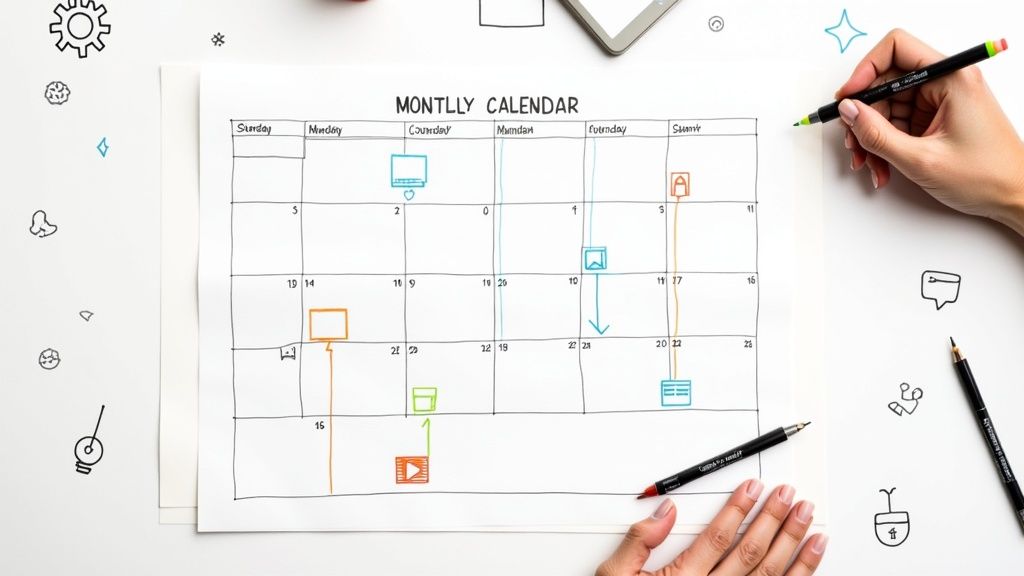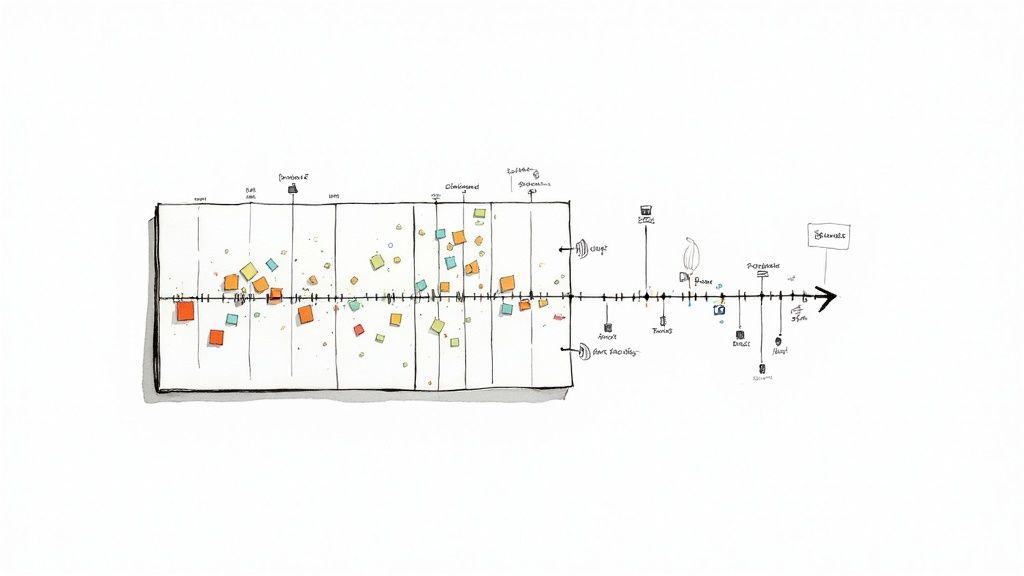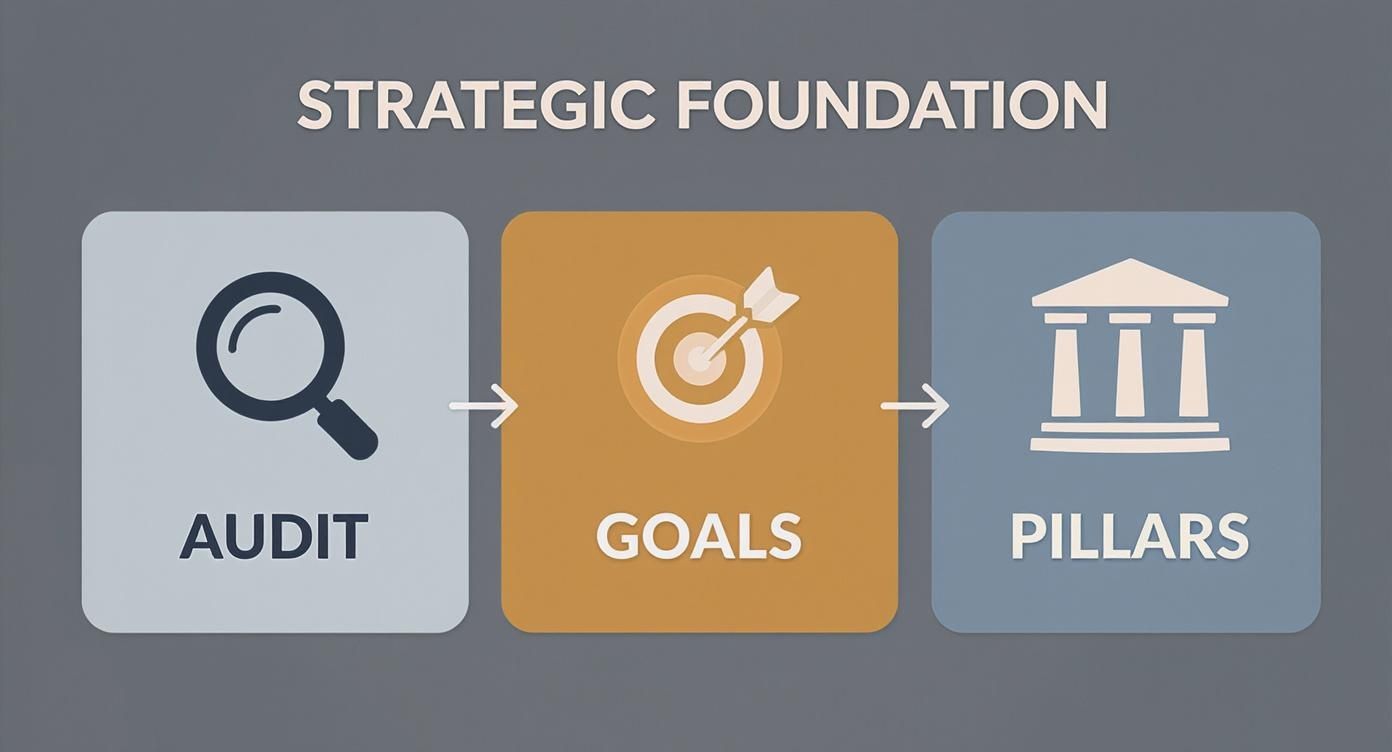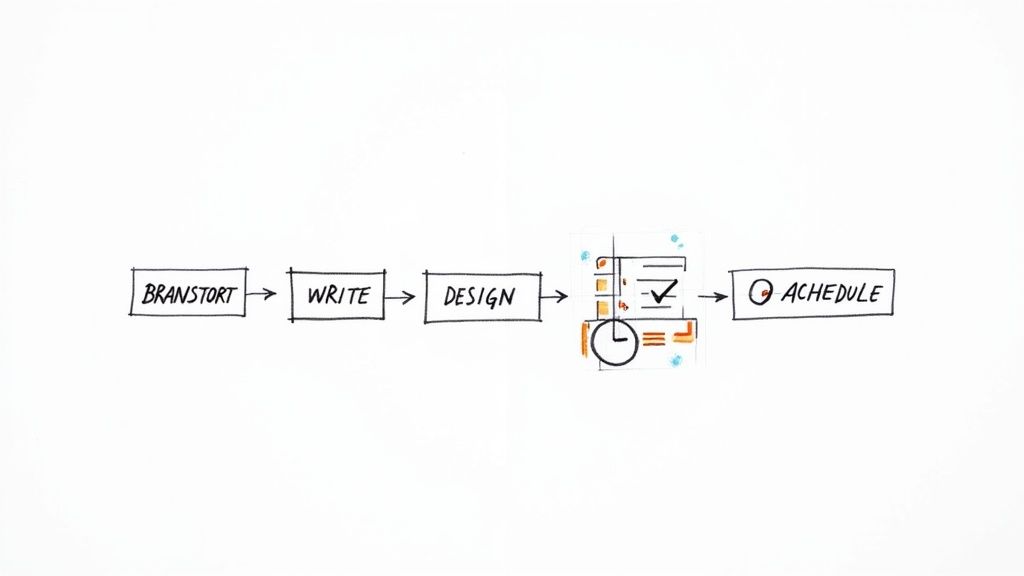
Mastering Real Estate Lead Generation: Proven Strategies for 2025
Master real estate lead generation in 2025 with proven strategies. Learn digital marketing, social media, and conversion tactics to grow your business.

Building a social media content calendar boils down to four key steps: auditing your current channels, setting trackable goals, choosing core content pillars, and establishing a consistent posting rhythm. This structured plan transforms random, last-minute posts into a smart, goal-oriented strategy where every piece of content has a purpose.
A great content calendar isn't just a scheduler—it's the backbone of an effective social media presence. It’s the difference between shouting into the void and executing a strategy that drives business results. Think of it as your roadmap for turning chaotic activity into a reliable marketing engine.

This proactive approach eliminates the daily "what do I post today?" panic. Instead, you gain an organized workflow that sharpens your brand voice, keeps your team aligned, and frees you up to engage with your audience. Brands using a solid calendar can see up to 40% higher engagement compared to those posting on the fly.
For a deeper dive, this a comprehensive guide on how to create a social media content calendar covers the fundamentals well.
Getting organized delivers tangible benefits that impact your bottom line.
A well-maintained calendar helps you move from being reactive to proactive. Instead of chasing trends, you can strategically incorporate them into a pre-planned schedule, ensuring you never miss an opportunity to connect.
Furthermore, a calendar simplifies performance tracking. You can clearly see metrics like impressions and conversions. It’s no surprise that over 40% of brands are increasing their investment in data-driven marketing, using analytics to fine-tune their content calendars.
Before deciding what to post, you must define why you’re posting. Many businesses jump into filling a calendar without a clear strategy, leading to wasted time and effort. Start by auditing your existing social media channels to see what has worked. Which posts generated conversations? What content drove website traffic? This process provides a baseline by revealing what your audience truly wants.
With an understanding of your past performance, set specific goals using the SMART framework—Specific, Measurable, Achievable, Relevant, and Time-bound. A good goal makes a tangible impact on your business.
Consider what you want to achieve:
Your goals directly shape your content. Lead generation requires compelling calls-to-action, while brand awareness might focus on shareable videos. Understanding your audience is equally crucial. Our guide on how to create buyer personas can help you clarify who you're talking to.
The final piece is defining your 3-5 core content pillars. These are the main themes you’ll consistently address. For a coffee shop, pillars could be Behind-the-Scenes Brewing, Customer Spotlights, and Community Events. These pillars ensure every post is on-brand and tells a cohesive story.
Now it's time to decide what you’re going to post and when. A great social media calendar requires variety. You can't rely solely on static images; mix it up with videos, carousels, Stories, and user-generated content.
What works on one platform may fail on another. A detailed LinkedIn article would be out of place on TikTok, where short, energetic videos reign. Your content strategy helps you make these platform-specific decisions.

Your audit shows where you've been, your goals define where you're going, and your content pillars are the routes to get there. Every content decision should align with this plan.
Next, set a realistic posting schedule. Consistency is far more important than frequency. It’s better to publish three high-quality posts per week than seven mediocre ones.
Each platform has different expectations for posting frequency. Mastering effective social media planning strategies is key to building your brand without overwhelming your audience or yourself. Start by analyzing your own data to see when your followers are most active.
For instance, on Instagram, video posts can get 49% more engagement than static photos, while video on LinkedIn drives five times more engagement. A content calendar allows you to plan for these high-impact formats intentionally.
The goal is to tailor every post to its platform and audience. If you need help organizing, our content marketing planning template is a great starting point.
Use the following table as a guideline, but always check your own analytics to refine these times for your specific audience.
Test different approaches, see what resonates with your followers, and adjust your calendar accordingly.
Your social media strategy needs a central hub for planning, creating, and scheduling. The right tool can be the difference between a plan that works and one that fizzles out. You don't need the most expensive platform; you need the one that fits your workflow.
For solo entrepreneurs or small teams, a spreadsheet like Google Sheet or Excel is a great, free starting point. As you grow, you may need more advanced features.
Dedicated social media management platforms like Buffer, Sprout Social, or Later offer built-in schedulers, deep analytics, and collaboration features that save time.
To choose the right tool, ask yourself:
Your tool must serve as your team's single source of truth for social media, eliminating confusion and providing clarity.
The best tool is one your team will use consistently. Start simple and upgrade only when necessary. A functional calendar used daily is better than a perfect one that gathers dust.
A great calendar is just a plan; a smooth, repeatable process brings it to life. This system turns ideas into high-quality posts without last-minute stress.
Start by defining clear stages for content creation: idea, copy, design, and final review. When everyone knows their role and deadlines, you eliminate frustrating bottlenecks.

For maximum efficiency, adopt content batching. Dedicate specific blocks of time to single tasks. For example, spend Monday morning brainstorming ideas, write all captions in the afternoon, and create all visuals on Tuesday.
This method offers several benefits:
Once content is approved, schedule it using a dedicated tool. This ensures posts go live at optimal times, even when you're offline, allowing you to focus on real-time community engagement. To accelerate the process, explore AI-powered content creation for generating fresh ideas and first drafts.
A streamlined workflow isn't about rigidity. It's about creating a predictable system that frees up mental energy for creativity, turning your calendar into a dynamic tool that works for you.
Even with a solid plan, questions will arise. Addressing common issues early can help you build and maintain momentum.
Aim to plan one month in advance. This provides enough time for creativity—brainstorming, creating quality graphics, and writing thoughtful copy—while remaining agile enough to react to trends or industry news. While a major launch might require a 90-day plan, a monthly schedule is ideal for everyday content consistency.
Don't panic. If engagement is low or you aren't seeing results, it's time to investigate. A content calendar is a living document meant to be adjusted.
A calendar that isn't performing is simply data showing you what to do differently. View it as a learning opportunity, not a failure.
Dive into your analytics. Are certain content pillars underperforming? Are you posting at the wrong times? Revisit your audience research and run simple tests. Try a new call-to-action, a different headline style, or a new format. Small adjustments can make a big impact.
Inspiration is everywhere. Start by breaking down your content pillars into smaller sub-topics.
Still stuck? Here are a few sources for fresh ideas:
Ready to build a powerful marketing strategy that fuels real growth? BrandBooster.ai combines expert insights with advanced AI to create a 100-day content plan designed to deliver results. See how we can boost your brand at https://www.brandbooster.ai.